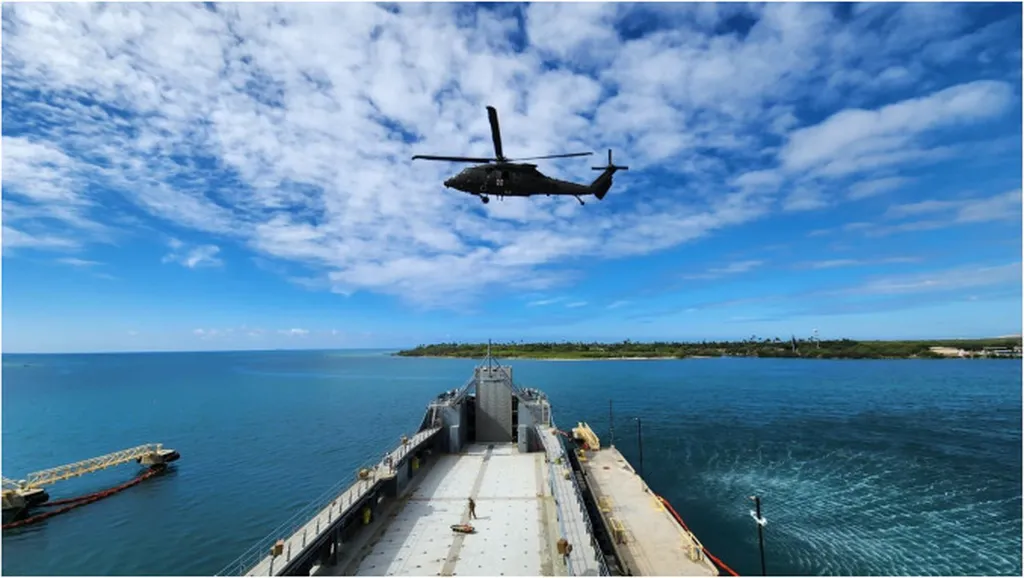In the realm of aeromedical evacuation, the concept of ambulance exchange points has long been a cornerstone for transferring patients between evacuation platforms en route to advanced medical care. However, a groundbreaking study led by researchers Mahdi Al-Husseini, Kyle H. Wray, and Mykel J. Kochenderfer introduces a novel approach to maritime medical evacuation, leveraging underway watercraft as overwater ambulance exchange points. This innovative strategy aims to enhance the efficiency and effectiveness of medical evacuations, particularly in maritime environments.
The research team collaborated with the United States Army’s 25th Combat Aviation Brigade to demonstrate the feasibility of using an Army watercraft as an overwater ambulance exchange point. The demonstration involved transferring a manikin between two HH-60 Medical Evacuation Black Hawk helicopters conducting hoist operations over the Army Logistics Support Vessel 3, which was traveling south of Honolulu, Hawaii. This exercise showcased the potential for watercraft to serve as dynamic, flexible exchange points for patient transfers, significantly expanding the capabilities of aeromedical evacuation in overwater scenarios.
Central to the success of this demonstration was the integration of advanced technologies. The researchers utilized a decision support system for dispatching aircraft, ensuring optimal routing and coordination. Hoist stabilization technology was employed to facilitate safe and precise transfers between the helicopters and the watercraft. Additionally, commercial satellite internet, military geospatial infrastructure applications, and digital medical documentation tools played crucial roles in enhancing communication, navigation, and patient care documentation throughout the process.
The benefits of this approach are manifold. By co-opting watercraft as overwater ambulance exchange points, medical evacuation teams can extend their operational reach and adapt to dynamic maritime conditions. This capability is particularly valuable in scenarios where traditional exchange points are unavailable or impractical, such as during natural disasters or in remote maritime regions. The use of advanced technologies further ensures that patient transfers are conducted with the highest levels of safety and efficiency, ultimately improving patient outcomes.
The researchers also introduced three extensions of the overwater ambulance exchange point concept, exploring additional applications and potential enhancements. These extensions include the use of unmanned aerial vehicles (UAVs) for reconnaissance and support, the integration of autonomous watercraft for enhanced flexibility, and the development of advanced communication protocols to streamline coordination between evacuation platforms. These innovations hold the potential to further revolutionize maritime medical evacuation, making it more adaptable, efficient, and effective.
Beyond military applications, the study also considered civilian uses for this concept. In scenarios such as offshore accidents, natural disasters, or medical emergencies in remote maritime regions, the ability to use watercraft as overwater ambulance exchange points could prove invaluable. By leveraging existing technologies and infrastructure, civilian medical evacuation teams could significantly enhance their capabilities, ensuring timely and effective care for patients in need.
The research conducted by Al-Husseini, Wray, and Kochenderfer represents a significant advancement in the field of aeromedical evacuation. By introducing the concept of watercraft as overwater ambulance exchange points, they have opened up new possibilities for enhancing the efficiency and effectiveness of maritime medical evacuations. The successful demonstration with the 25th Combat Aviation Brigade underscores the feasibility of this approach and highlights the transformative potential of integrating advanced technologies into medical evacuation operations. As this concept continues to evolve, it holds promise for both military and civilian applications, ultimately contributing to improved patient outcomes and enhanced medical care in challenging environments. Read the original research paper here.

